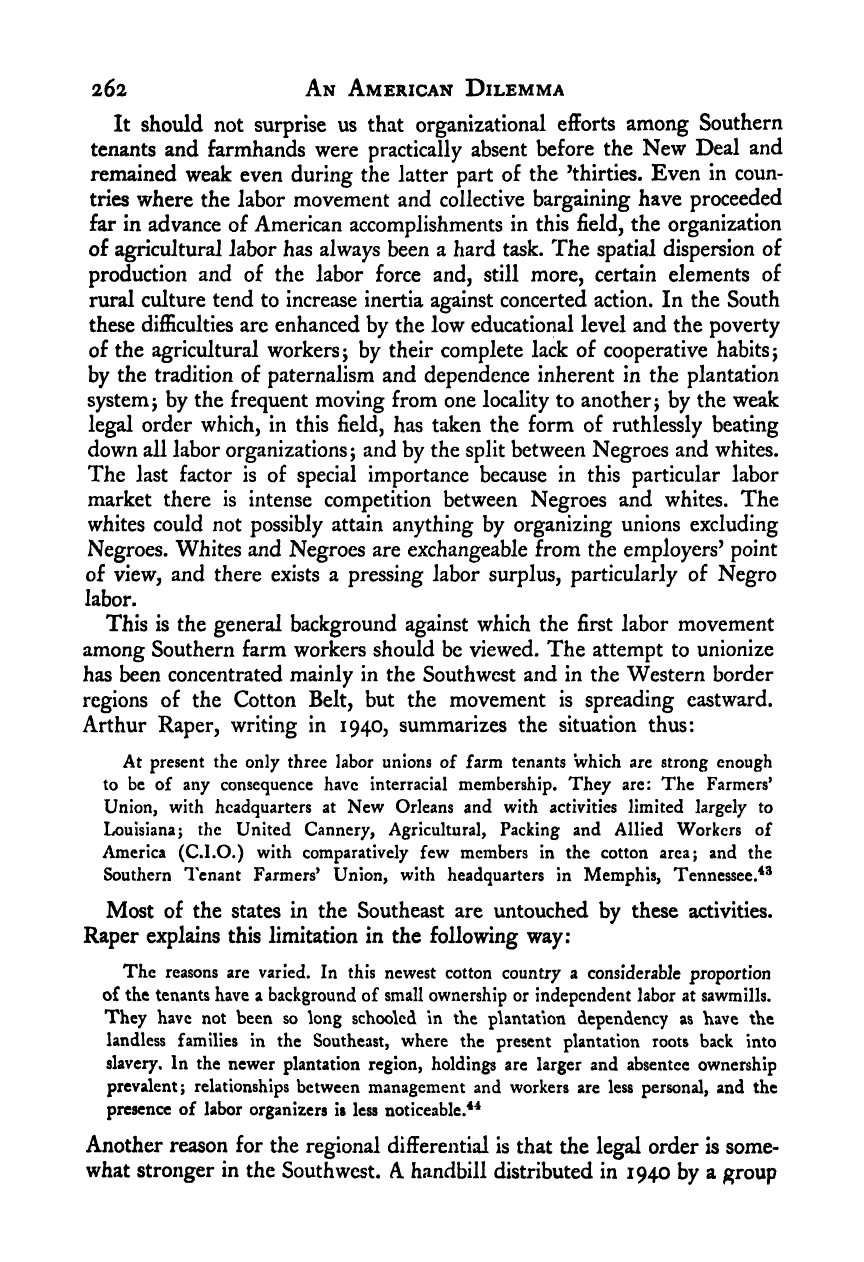Note: Gunnar Myrdal died in 1987, less than 70 years ago. Therefore, this work is protected by copyright, restricting your legal rights to reproduce it. However, you are welcome to view it on screen, as you do now. Read more about copyright.
Full resolution (TIFF) - On this page / på denna sida - IV. Economics - 12. New Blows to Southern Agriculture During the ’Thirties: Trends and Policies - 7. Labor Organizations

<< prev. page << föreg. sida << >> nästa sida >> next page >>
Below is the raw OCR text
from the above scanned image.
Do you see an error? Proofread the page now!
Här nedan syns maskintolkade texten från faksimilbilden ovan.
Ser du något fel? Korrekturläs sidan nu!
This page has never been proofread. / Denna sida har aldrig korrekturlästs.
262 An American Dilemma
It should not surprise us that organizational efforts among Southern
tenants and farmhands were practically absent before the New Deal and
remained weak even during the latter part of the ’thirties. Even in coun-
tries where the labor movement and collective bargaining have proceeded
far in advance of American accomplishments in this field, the organization
of agricultural labor has always been a hard task. The spatial dispersion of
production and of the labor force and, still more, certain elements of
rural culture tend to increase inertia against concerted action. In the South
these difficulties arc enhanced by the low educational level and the poverty
of the agricultural workers 5
by their complete lack of cooperative habits 5
by the tradition of paternalism and dependence inherent in the plantation
system j
by the frequent moving from one locality to another j
by the weak
legal order which, in this field, has taken the form of ruthlessly beating
down all labor organizations; and by the split between Negroes and whites.
The last factor is of special importance because in this particular labor
market there is intense competition between Negroes and whites. The
whites could not possibly attain anything by organizing unions excluding
Negroes. Whites and Negroes are exchangeable from the employers’ point
of view, and there exists a pressing labor surplus, particularly of Negro
labor.
This is the general background against which the first labor movement
among Southern farm workers should be viewed. The attempt to unionize
has been concentrated mainly in the Southwest and in the Western border
regions of the Cotton Belt, but the movement is spreading eastward.
Arthur Raper, writing in 1940, summarizes the situation thus:
At present the only three labor unions of farm tenants which are strong enough
to be of any consequence have interracial membership. They arc: The Farmers*
Union, with headquarters at New Orleans and with activities limited largely to
Louisiana j
the United Cannery, Agricultural, Packing and Allied Workers of
America (C.l.O.) with comparatively few members in the cotton area; and the
Southern Tenant Farmers’ Union, with headquarters in Memphis, Tennessee.^*
Most of the states in the Southeast are untouched by these activities.
Raper explains this limitation in the following way:
The reasons are varied. In this newest cotton country a considerable proportion
of the tenants have a background of small ownership or independent labor at sawmills.
They have not been so long schooled in the plantation dependency as have the
landless families in the Southeast, where the present plantation roots back into
slavery. In the newer plantation region, holdings are larger and absentee ownership
prevalent; relationships between management and workers are less personal, and the
presence of labor organizers is less noticeable.^^
Another reason for the regional differential is that the legal order is some-
what stronger in the Southwest. A handbill distributed in 1940 by a group
<< prev. page << föreg. sida << >> nästa sida >> next page >>